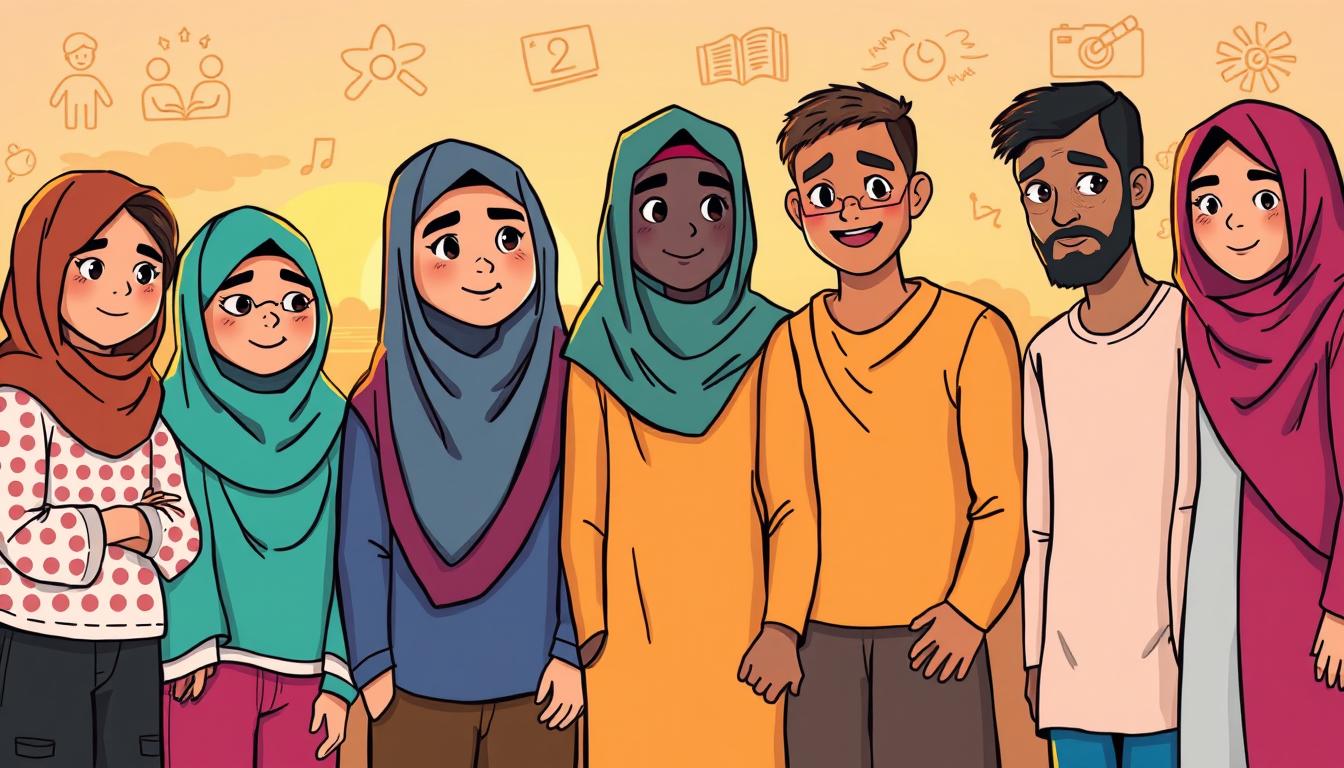5 Challenges Facing Muslim Youth Today – and Solutions
Are Muslim youth in America caught between two worlds? This question is common among young Muslims. They face challenges like Islamophobia and cultural conflicts.
Muslim youth balance Islamic values with Western culture. This can cause an identity crisis. They try to honor their faith while fitting into society.
Islamophobia is a big problem. 48% of Muslim youth face bullying or harassment because of their faith. This hurts their mental health and sense of belonging.
Online temptations are another challenge. 72% of Muslim youth deal with things like gambling and haram relationships online. They need strong support to stay true to their faith.
But, there are solutions. Education is key. Islamic education helps young Muslims find their place. Community support and interfaith dialogues also help them thrive.
Key Takeaways
- 65% of Muslim youth struggle with balancing cultural expectations and Islamic teachings
- 48% experience bullying or harassment due to their faith
- 80% feel pressured to be perfect ambassadors of Islam
- 72% face online temptations that conflict with Islamic values
- Islamic education and community support are crucial for empowering Muslim youth
Understanding the Muslim Youth Experience in America
The Muslim youth experience in America is shaped by a rich history and diverse demographics. Over the past five decades, Muslim immigration to the United States has changed a lot. This has created a complex landscape for young Muslims today.
Muslim Immigration History
Muslim immigration to the USA started before the 1960s. The community grew a lot when students from South Central Asia and the Middle East came in the late sixties. These students, who were not always Muslim, played a big role in helping the immigrant Muslim community.
Muslim Youth Demographics
Today, Muslim youth demographics show a mix of ethnicities and national origins. This diversity comes from immigration waves and the growth of Muslim populations in the USA. Muslim youth meet non-Muslim peers every day in schools, shopping centers, and social events. This makes their American experience unique.
Generational Challenges
Second and third-generation Muslims face unique challenges. They often struggle to mix Islamic values with Western culture. Key issues include:
- Lacking religious identity
- Conflicting cultures
- Confused citizenship
- Misguiding social norms
- Influential peer pressure
These challenges come from the complex mix of issues. This includes the isolated Muslim communities that formed due to differences in ideology, culture, and vision for Muslims in America. The aftermath of 9/11 has made these challenges even harder, with more Islamophobic sentiments adding to the complexity of the Muslim youth experience.
Islamophobia and Discrimination: A Growing Concern
Anti-Muslim sentiment has grown a lot in recent years. UN Secretary-General António Guterres has spoken out against hate targeting Muslims and other groups. This rise in discrimination led to an International Day to Combat Islamophobia, backed by 60 countries.
Muslim bullying in schools is a big problem. Studies show over half of Muslim students face bullying. Nearly a third of those wearing hijabs experience offensive touching. This problem isn’t just in schools; it affects jobs and social life too.
Islamophobia’s impact on health is big. It can cause stress, make people hide their identity, and lead to health problems. Muslims in America often deal with depression, anxiety, and heart issues because of discrimination.
“Hate crimes against Muslims in the United States remain 5 times more common than before September 11, 2001.”
To tackle these issues, several efforts have been made:
- The UN Strategy and Plan of Action on Hate Speech
- Public education campaigns to fight misconceptions
- Interfaith dialogues to build understanding
- Anti-discrimination policies in schools and workplaces
- Community outreach programs to build bridges
By using these solutions and pushing for inclusivity, we can fight anti-Muslim sentiment. This will help create a more welcoming society for everyone.
Identity Crisis and Cultural Integration Struggles
Young American Muslims face unique challenges. They must balance their Islamic values with Western culture. A study of 30 Muslim youth aged 16-20 shows the complexity of cultural integration.
Among the participants, 24 were children of immigrants. This highlights the dual identity many navigate.
Balancing Islamic Values and Western Culture
The struggle for cultural integration is evident in daily choices. Fifteen young women interviewed wore hijab regularly. This shows their commitment to Islamic traditions.
Yet, wearing hijab can sometimes clash with Western norms. This creates pressure to assimilate.
Navigating Dual Identities
The concept of dual identity is a significant challenge. A study found that 1 in 2 Muslim children were unsure if they could be both Muslim and American. This uncertainty can lead to identity crises.
1 in 6 children sometimes pretend not to be Muslim. This shows the struggle they face.
Assimilation Pressure vs. Cultural Heritage
Young Muslims often feel compelled to prove their “Americanness.” This is due to prevalent stereotypes. This pressure can conflict with maintaining cultural heritage.
Interestingly, research shows that strong religious identities can boost civic engagement. Mosque-goers are more likely to participate in community problem-solving and voting.
- 26 out of 30 interviewees were regular mosque-goers
- Muslims who attend mosques regularly are more civically engaged
- Young Muslim women navigate modern Islamic fashion to avoid labels
These findings underscore the need for support systems. They help Muslim youth embrace their dual identities. This fosters both cultural integration and preservation of heritage.
5 Challenges Facing Muslim Youth Today – and Solutions
Muslim youth in America face many challenges. They must balance cultural traditions with modern life. They also deal with discrimination every day.
One big challenge is keeping their faith strong while living in the West. Many doubt their beliefs when they see different worldviews. To help, they can strengthen ties with the Muslim community and follow Islamic teachings.
Another challenge is figuring out their identity. Being both Muslim and American can be tough. Talking openly about their heritage and being proud of it can help.
- Combating Islamophobia through education and dialogue
- Balancing religious observances with academic or work commitments
- Navigating social pressures while adhering to Islamic values
- Addressing mental health concerns within the community
- Seeking positive representation in media and popular culture
Dealing with parental expectations and generational gaps is another issue. It’s important for parents and kids to talk more. Young Muslims can manage their time better and reduce stress.
Young Muslims can find support from mentors and join community activities. They can also take part in leadership programs. By facing these challenges, they can grow and stay true to their faith and culture in America.
Peer Pressure and Social Expectations
Muslim youth face unique challenges with peer pressure and social norms. Islamic values often clash with mainstream culture. This makes it hard for young Muslims to navigate their social world.
Dealing with Non-Islamic Social Norms
Young Muslims struggle with social expectations that don’t match their religious beliefs. They might feel pressured to drink alcohol, date, or eat foods against Islamic rules. A study in Melbourne, Australia, showed these concerns among 33 young people aged 16-22.
Navigating Friendships and Relationships
It’s tough for Muslim youth to make friends while staying true to their faith. They might feel like they’re choosing between their religious identity and fitting in. The International Muslim Youth Conference at the University of Chester talked about these challenges.
Resisting Negative Influences
It’s important for young Muslims to balance their faith with social connections. They found that breaks from technology during prayer and quality family time helped their mental health. This way, they can avoid bad influences without cutting themselves off from friends.
- Seek support from family and community
- Strengthen faith through religious practices
- Connect with like-minded peers who share similar values
By understanding these challenges and using supportive strategies, Muslim youth can handle peer pressure and social expectations. They can stay true to their faith and values.
Limited Representation in Media and Popular Culture
Muslims face a big challenge in media. Islamic stories are often shown in a way that makes people think wrongly about Muslims. This lack of variety in media leads to wrong ideas about Islamic communities.
Young Muslims often feel left out and discriminated against. Media doesn’t always show them in a good light. This can make it hard for Muslim youth to find their place.
The entertainment world has a big impact on what we think. By showing more Muslim talent and telling different stories, media can change how we see things. Working with Muslim groups and teaching media folks about Islam can help show the real picture.
“We need to see more authentic Muslim characters in movies and TV shows. It’s not just about representation; it’s about showing the rich diversity within our community.”
Things are slowly getting better, but we still have a long way to go. Some groups are pushing for more accurate Muslim stories in media. Their goal is to make media more inclusive and show the real variety of Muslim lives.
- Advocate for better Muslim representation in media
- Support Muslim creators and storytellers
- Educate media professionals about Islamic culture
- Promote diverse Muslim narratives in popular culture
By tackling these problems, we can make media that really shows the Muslim community in all its beauty and complexity.
Balancing Religious Observances with Daily Life
Muslim youth have to find ways to fit Islamic practices into their busy lives. This is especially hard in places where Islamic traditions are not well-known. They need to be creative and determined to make it work.
Prayer Times and School Schedules
It’s hard to find time for prayers during school hours. Many Muslim students look for quiet spots or unused classrooms. Some schools have started to provide special prayer areas, showing they are making an effort to be more inclusive.
Ramadan Fasting and Academic Performance
Fasting during Ramadan can make it tough to keep up with schoolwork. Muslim students often study early in the morning or late at night when they have more energy. Schools can help by scheduling big exams when Ramadan is not happening.
Islamic Dress Codes in Various Settings
Following Islamic dress codes can be tough in different places. Muslim girls wearing hijabs might get asked a lot of questions. Some workplaces have rules that go against Islamic dress. Talking openly about religious needs can help everyone understand each other better.
“Making Islam joyful for youth through engaging activities and involvement in charity projects can significantly impact their ability to balance faith and daily life.”
Despite the challenges, many Muslim youth manage to balance their faith and daily life. With support from schools, workplaces, and communities, it gets easier. This balance helps them feel strong in their faith and makes society more diverse and understanding.
Addressing Mental Health and Well-being
Muslim youth face unique challenges with mental health. Studies show 1 in 6 U.S. youth aged 6-17 have a mental health disorder each year. For Muslim youth, cultural stigma and discrimination add to their struggle.
American Muslims are twice as likely to have attempted suicide compared to other groups. This shows the urgent need for culturally sensitive mental health services. Many Muslim youth find it hard to seek help because of community stigma around mental illness.
Islamic counseling is key in supporting youth well-being. It combines Islamic principles with modern therapy. This way, counselors offer support that Muslim youth can relate to. It helps them deal with the pressure of balancing identities and cultural expectations.
“Seeking help is a sign of strength, not weakness. Our faith encourages us to take care of our mental health just as we care for our physical health.”
Community leaders can fight stigma by inviting mental health experts to talk. This can make talking about mental health normal in the Muslim community. By starting open conversations, we can make a space where youth feel safe to ask for help.
- Promote awareness of mental health issues in mosques and community centers
- Provide access to culturally competent mental health professionals
- Encourage open conversations about mental health within families
- Integrate mental health education into Islamic studies curricula
By tackling Muslim mental health concerns, we can help our youth thrive. Let’s work together to build a community that supports everyone’s well-being.
Empowering Muslim Youth Through Education and Community Support
Education and community support are key to helping Muslim youth succeed in America. By learning both Islamic teachings and secular subjects, they gain a strong sense of who they are and their place in the world.
Islamic Education and Secular Studies
Learning both Islamic teachings and secular subjects helps Muslim youth understand their dual identities. This mix of education gives them a solid base in faith and prepares them for life in the wider world. Many mosques and community centers have programs that mix Quranic studies with homework and college prep.
Youth Development in Mosques and Community Centers
Mosques and Muslim community centers are key places for young people to grow. They offer safe spaces for socializing, learning, and personal development. Activities like sports, art, and volunteering help build confidence and leadership skills.
Mentorship and Role Models
Youth mentorship programs link Muslim teens with successful people who share their faith. These mentors offer guidance, inspiration, and advice on career paths. Seeing successful Muslims in different fields helps young people dream big about their futures.
“Mentorship plays a crucial role in empowering Muslim youth to reach their full potential while staying true to their values.”
By focusing on education, community involvement, and mentorship, we can empower the next generation of Muslim Americans. They will be confident, successful, and proud of their heritage.
Conclusion
Muslim youth in America face unique challenges. But, there are promising solutions for their empowerment. Education is key in addressing these issues.
By developing critical thinking and argumentation skills, young Muslims can better navigate their dual identities. They can also counter misconceptions about Islam.
Community support is vital for Muslim youth solutions. Mosques, Islamic centers, and mentorship programs provide safe spaces. These spaces help youth explore their faith and culture.
These initiatives build confidence and foster a sense of belonging. This is crucial for the American Muslim future.
Research shows that focusing on positive youth development and mental health is essential. By promoting strengths-based approaches and addressing mental well-being, we can empower Muslim youth. This ensures a brighter future for young Muslims in America.
As we move forward, empowering Muslim youth requires a multi-faceted strategy. By combining education, community support, and mental health initiatives, we can help young Muslims. They can confidently embrace their identities and contribute positively to American society.
Source Links
- 4 Challenges of Muslim Youth in the West | About Islam
- Muslim Youth And Modern Educational Challenges
- Challenges Facing Islam, Islamic Civilization, and Muslim Countries
- Microsoft Word – MuslimyouthChallangesandSolutions-Qaddora.doc
- 5 major Muslim Youth Challenges with its Solution in USA
- Our Muslim Youth Are Hurting | Yaqeen Institute for Islamic Research
- International Day to Combat Islamophobia | United Nations
- Islamophobia and Public Health in the United States
- Exploring the Faith and Identity Crisis of American Muslim Youth | Yaqeen Institute for Islamic Research
- The “Identity Crisis” of Younger Muslims
- Top 10 Issues & Solutions
- What Are the Major Issues for Muslim Youth Today? – The Halal Times
- Social Media and Online Digital Technology Use Among Muslim Young People and Parents: Qualitative Focus Group Study
- Muslim Youth: Challenges, Opportunities and Expectations 9781472548658, 9781441122995, 9781441119872 – DOKUMEN.PUB
- Psychological Stress and Coping in Adolescent Muslim New Zealanders:
A Key Informant Perspective - Media Representation | Perception Institute
- Microsoft Word – Roundtable Muslims Report-Final.doc
- Raising Resilient Muslim Youth: Strategies for Building a Strong Muslim Identity in Children | Yaqeen Institute for Islamic Research
- 5 Factors that Build Confidence in Muslim Youth | muslimdirectoryapp |
- Muslim Youth and Mental Health Challenges – Issuu
- Mental health advice for young Muslims
- Empowering Muslim Youth | My Legacy
- Challenges and Opportunities for Muslim Youth – The Community on Friday
- The Challenges and Solutions for Quality Education for Muslims in Northern India.
- The Problems Faced by the Muslim Ummah and Their Solutions
- A Decade of Muslim Youth: Global Trends in Research







